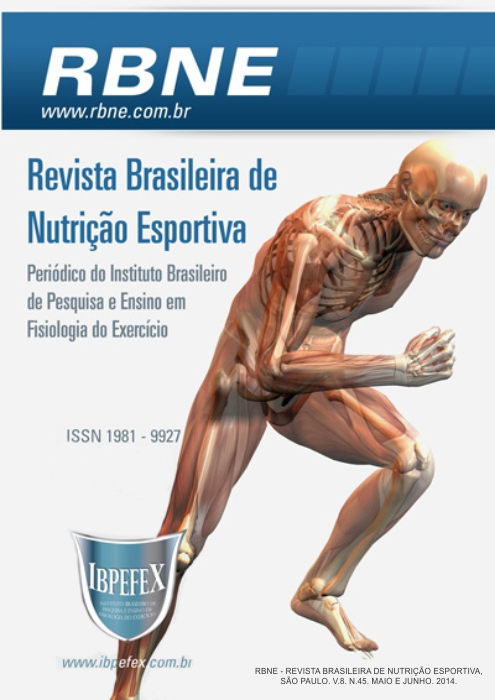Dose effect of maltodextrin in blood glucose and cardiovascular response in diabetes type 2 during aerobic exercise
Abstract
Introduction: The present study investigated the effect of supplementation with different doses of maltodextrin. Before,during and after an exercise protocol with continuous loads predominantly aerobic blood glucose levels and cardiovascular variables in patients with T2 DM. Materials and Methods: Six patients diagnosed with T2 DM, aged between 40 and 60 years, were supplemented with different doses of carbohydrates (100 mg/kg, 1g/kg e 2g/kg), for 40 minutes of aerobic exercise at 40% heart rate reserve (FCreserve) evaluating cardiorespiratory parameters and blood glucose. We used the ANOVA, and considered significant value than p<0.05. Results: The results showa significant differencein blood glucose for the supplementation of 100 mg/kg of maltodextrin inrelation to the group 1 g/Kg (32%, 66 mg/dL; p=0,03) and supplemented with 2g/kg (38%, 79 mg/dL; p=0,02) 40 minutes during the exercise protocolat 40% of FCreserve and 10 minutes after exercise. Discussion: Supplementation with 100mg/kg maltodextrin can be an effective strategy for preventing rebound hypoglycemia after physical exercise. Conclusion: Control of rebound hypoglycemia with 100mg/kg of maltodextrin.
References
-American College of Sports Medicine. Exercise and Type 2 diabetes. Med Sci Sport Exerc. Vol. 42. Núm. 12. p. 2282-2303. 2010.
-American Diabetes Association. Diagnosis and classification of diabetes mellitus. Diabetes Care. Vol. 33. Núm. 1. p. 62-69. 2010.
-American Diabetes Association. Physical Activity/Exercise and Diabetes Mellitus. Diabetes Care. Vol. 29. Núm. 1. p. 1433-38. 2004.
-Andrade, R.; Laitano, O.; Meyer, F. Efeito da hidratação com carboidratos na resposta glicêmica de diabéticos tipo I durante o exercício. Rev Bras Med Esporte. Vol. 11. Núm. 1 p. 61-65. 2005.
-Atkinson, F.S.; Foster-Powell, K.; Brand-Miller, J.C. International Tables of Glycemic Index and Glycemic Load Values. Diabetes Care. Vol. 31. Núm. 12. p. 2281-2283. 2008.
-Blaak, E.E.; Van Aggel-Leijssen, D.P.; Wagenmakers, A.J.; Saris, W.H.; Van Baak, M.A. Impaired oxidation of plasma-derived fatty acids in type 2 diabetic subjects during moderate-intensity exercise. Diabetes. Vol. 49. p. 2102-7. 2000.
-Borg, G.; Noble, B.J. Psycophysical bases of perceived exertion. Med Sci Sports Exerc. Vol. 14. p. 377-381. 1982.
-Coggan, A.R.; Swanson, S.C. Nutritional manipulations before and during endurance exercise: effects on performance. Med Sci Sports Exerc. Vol. 24. Núm. 9. p. 331-335. 1992.
-Cyrino, E.S.; Zucas, S.M. Influência da ingestão de carboidratos sobre o desempenho físico. Rev Educ Fis/UEM. Vol. 10. Núm. 1. p. 73-79. 1999.
-Eriksson, J.; Taimela, S.; Koivisto, V.A. Exercise and the metabolicsyndrome. Diabetologia. Vol. 40. p. 125-35. 1997.
-Huskisson, E.C. Measurement of pain. Lancet. Vol. 2. p. 1127-31. 1974.
-Jackson, A.S.; Pollock, M.L.; Graves, J.E.; Mahar, M.T. Reliability and validity of bioelectrical impedance in determining body composition. JAppl Physiol. Vol. 64. p. 529-34. 1988.
-Jentjens, R.L.; Cale, C.; Gutch, C.; Jeukendrup, A.E. Effects of pre-exercise ingestion of differing amounts of carbohydrate on subsequent metabolism and cycling performance. Eur J Appl Physiol. Vol. 88. Núm. 4. p. 444-452. 2003.
-Kahn, S.E.; Larson, V.G.; Beard, J.C.; Cain, K.C.; Fellingham, G.W.; Schwartz, R.S. Effects of exercise on insulin action, glucose tolerance, and insulin secretion in aging. Am J Physiol. Vol. 258. p. 937-43. 1990.
-Kelley, D.E.; Simoneau, J.A. Impaired free fatty acid utilization by skeletal muscle in non-insulin-dependent diabetes mellitus. J Clin Invest. Vol. 94. p. 2349-56. 1994.
-Kline, G.M.; Porcari, J.P.; Hintermeister, R.; Freedson, P.; Ward, A.; McCarron, R. Estimation of VO2maxfrom a one-mile track walk, gender, age, and body weight. Med Sci Sports Exerc. Vol. 19. Núm. 2. p. 253-59. 1987.
-Mamus, R.; Santos, M.G. Efeitos bioquímicos da suplementação de carboidratos após uma competição simulada de short duathlon terrestre. Rev Port Cien Desp. Vol. 6. Núm. 1. p. 29-37. 2006.
-Miller, J.P.; Pratley, R.E.; Goldberg, A.P.; Gordon, P.; Rubin, M.; Treuth, M.S. Strength training increases insulin action in healthy 50-to 65-yr-old men. J Appl Physiol. Vol. 77. p. 1122-7. 1994.
-Sapata, K.B.; Fayh, A.P.T.; Oliveira, A.R. Efeitos do consumo prévio de carboidratos sobre a resposta glicêmica e desempenho. Rev Bras Med Esporte. Vol. 12. Núm. 4. p. 189-94. 2006.
-Siri, W.E. Body composition from fluid spaces and density. Washington DC: National Academy of Science. p. 223-44. 1961.
-Vancini, R.L.; Lira, C.A.B. Aspectos gerais do diabetes Mellitus e exercício. Centro de Estudos de Fisiologia do Exercício. CEFE. Universidade Federal de São Paulo - UNIFESP; 2004.
-Wilmore, J.H.; Costill, D.L. Fisiologia do Esporte e do Exercício. São Paulo. Manole. 2001.
Authors who publish in this journal agree to the following terms:
- Authors retain the copyright and grant the journal the right of first publication, with work simultaneously licensed under the Creative Commons Attribution License BY-NC which allows the sharing of the work with acknowledgment of the authorship of the work and initial publication in this journal.
- Authors are authorized to enter into additional contracts separately for non-exclusive distribution of the version of the work published in this journal (eg, publishing in institutional repository or book chapter), with acknowledgment of authorship and initial publication in this journal.
- Authors are allowed and encouraged to post and distribute their work online (eg, in institutional repositories or on their personal page) at any point before or during the editorial process, as this can bring about productive change as well as increase impact and impact. citation of published work (See The Effect of Free Access).






